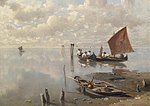Draft:Franz Leo Ruben
| Submission declined on 1 November 2023 by Vanderwaalforces (talk). This submission's references do not show that the subject qualifies for a Wikipedia article—that is, they do not show significant coverage (not just passing mentions) about the subject in published, reliable, secondary sources that are independent of the subject (see the guidelines on the notability of people). Before any resubmission, additional references meeting these criteria should be added (see technical help and learn about mistakes to avoid when addressing this issue). If no additional references exist, the subject is not suitable for Wikipedia.
Where to get help
How to improve a draft
You can also browse Wikipedia:Featured articles and Wikipedia:Good articles to find examples of Wikipedia's best writing on topics similar to your proposed article. Improving your odds of a speedy review To improve your odds of a faster review, tag your draft with relevant WikiProject tags using the button below. This will let reviewers know a new draft has been submitted in their area of interest. For instance, if you wrote about a female astronomer, you would want to add the Biography, Astronomy, and Women scientists tags. Editor resources
|  |
The topic of this draft may not meet Wikipedia's notability guideline for biographies. (May 2023) |
Franz Leo Ruben (Czech: František Ruben; 16 August 1842 – 18 December 1920) was an Austrian-German painter. He was the son of painter Christian Ruben.
Life[edit]
Franz Ruben was born on 16 August 1842 in Prague. He was the eldest son of the director of the Prague Academy Christian Ruben and his wife Susanna, née Dumbserová (1819–1903).[1] His grandfather was the Trier drawing teacher Karl Ruben (1772–1843), and the landscape painter Max Haushofer was his uncle.
Between 1859 and 1867 Franz Leo Ruben he studied at the Academy of Fine Arts Vienna.[2]
From 1868 he lived in Rome, where he completed his studies. There he was a member of the German Association of Artists (Deutscher Künstlerverein) and of the Society of Austrian Visual Artists (Gesellschaft bildender Künstler Österreichs).
His first prominent artwork was the altarpiece on the Miracle of the Rose of St. Elizabeth, painted for a Bohemian church.
Ruben mainly exhibited his works in large exhibitions at Vienna's Künstlerhaus, and his paintings also regularly appeared at exhibitions in Prague. [2]
In 1869 he was awarded the Reichel Prize, which enabled him to travel to Italy. After stays in Florence, he moved to Venice, where he lived for several periods between 1874 and 1914, until the outbreak of World War I.
Ruben was granted a note in the 1874 Biographisches Lexikon des Kaiserthums Oesterreich, stating that "According to specialist critics, Franz Ruben is an important, well-trained talent who promises to achieve excellence in history and the historical genre."[3]
From his residency in Italy, where he was made an honorary member of the art academy, Ruben supplied the major exhibitions in Vienna. In Venice, Ruben crafted numerous oil paintings with landscapes and colorful depictions of scenes from the lives of ordinary people, for which he got several awards at the world exhibitions in Vienna and Munich.[2] He was awarded medals at the World's Fair in 1873 and at an exhibition in Munich in 1883. In 1890 he contributed sketches to the Kronprinzenwerk.
Ruben was one of the artists to whom the composer Richard Wagner paid particular attention.[4] Ruben created scenes from Wagner's Lohengrin for the Bavarian King Ludwig IIs Hohenschwangau Castle.[5]
Following the Austrian occupation of Bosnia and Herzegovina in 1878 Ruben also travelled to Sarajevo, where he painted several scenes.
He spent his old age in Munich, where he died on 18 December 1920 at the age of 78.[2]
Works[edit]
Franz Leo Ruben often devoted himself to genre painting with Italian themes.
His 1863 painting Portrait of a Man is owned by the Gallery of the Central Bohemian Region in Kutná Hora.[6]
Gallery[edit]
-
Musestunde des Muschelverkäufers
-
Türkisches Kaffeehaus in Sarajevo
-
Vier Damen am Basar von Sarajevo
-
Venetianische Rosenkranzdrechsler (1875)
-
Venezianische Kesselflicker (1872)
-
Venezianisches Treiben (1878)
-
Badende Kinder
-
Campiello delle Mosche, Venice
-
Der Fächerverkäufer (1882)
-
Der kleine Freund (1886)
-
Eine elegante Bootsparty
-
Junge italienische Gemüseverkäuferin
-
Kinder auf der Brücke
-
Motiv aus Venedig (Kunsthistorisches Museum Wien)
-
Fischer in der Lagune (1891)
-
Mazzorbo
-
Am Flussufer
-
Ein türkischer Herr
-
Italienische Dorfstraße
References[edit]
- ^ "Policejní ředitelství I, konskripce, karton 521, obraz 541". Národní archiv.
- ^ a b c d Lempertz
- ^ BLKÖ:Ruben, Franz
- ^ Julius von Stepski: Geschichte und Intrige. Politische Erlebnisse aus einem halben Jahrhundert. Luser, Wien 1940, S. 82
- ^ John W. Barker: Wagner and Venice. University of Rochester Press, Rochester/NY 2008, ISBN 978-1-58046-288-4, S. 70 (Google Books)
- ^ "vyhledávání: Ruben Franz". Registr sbírek výtvarného umění ProMus.
Category:1920 deaths
Category:1842 births
Category:Artists from Prague
Category:Austrian painters
Category:German painters
Category:Articles with VIAF identifiers
Category:Articles with ULAN identifiers
Category:Articles with RKDartists identifiers
Category:Articles with ISNI identifiers
Category:Articles with GND identifiers
Category:Articles with NKC identifiers



















